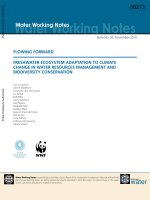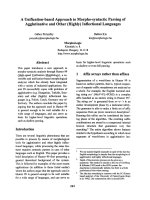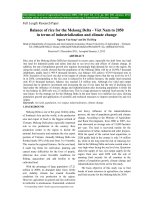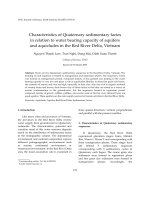Saffron (Crocus sativus L.) crop insurance to mitigate ill effects of climate change - A priority of Jammu and Kashmir state
Bạn đang xem bản rút gọn của tài liệu. Xem và tải ngay bản đầy đủ của tài liệu tại đây (706.75 KB, 13 trang )
Int.J.Curr.Microbiol.App.Sci (2019) 8(1): 2972-2984
International Journal of Current Microbiology and Applied Sciences
ISSN: 2319-7706 Volume 9 Number 01 (2019)
Journal homepage:
Original Research Article
/>
Saffron (Crocus sativus L.) Crop Insurance to Mitigate ill Effects of Climate
change - a Priority of Jammu and Kashmir State
F.A. Nehvi* and Salwee Yasmin
Sher-e-Kashmir, University of Agricultural Sciences and Technology of Kashmir, India
*Corresponding author
ABSTRACT
Keywords
Insurance, Weather,
Yield loss, Saffron,
Jammu and
Kashmir
Article Info
Accepted:
22 December 2018
Available Online:
10 January 2019
Climatic abnormalities observed in Kashmir over a couple of years (201417) has put saffron farming system under great distress leading to reduction
in overall production from 16.5 M.T recorded in 2013 to almost 1.5 M.T
recorded in 2017 and thus warrants to bring saffron cropping system under
crop insurance cover so as to save saffron growers from annual exchequer
loss of Rs 210 cores. Guidelines for weather based and yield based crop
insurance policies for saffron have been framed but the schemes are not
under operation till date and warrants prioritization of state policy makers.
Introduction
After implementation of National Saffron
Mission in 2010 by Agriculture Production
Department J and K Saffron farming system a
legendary crop of Jammu and Kashmir state
was on rise up till 2013, as overall Saffron
production of state increased from 9.46 M.T to
16.5 M.T with an increase in average
productivity from 2.5 to 4.4 kg/ha (Nehvi and
Salwe, 2017). However, excess precipitation
observed in 2014 by 53% (280 mm as against
requirement of 183 mm) during sprouting
stage (August-October) lead to decline in
saffron production of J and K state by 70%
(4.5 M.T as against 15 M.T recorded during
2013). Similarly, precipitation deficit during
sprouting stage recorded by 56.9 % in 2016
and 100% in 2017 lead to decline in saffron
production by 91% during 2017 (from 16.5
M.T recorded in 2015 to 1.5 M.T recorded in
2017). Excess summer precipitation associated
with high humidity has become concern of
saffron growers as during 2015 saffron
growers lost about 30% of corms due to corm
rot caused by fungal infestation as saffron area
recorded 400% more precipitation from May
to July (550 mm as against normal
precipitation of 110 mm) Figure 1 and 2
(Salwe et al., 2016). All these factors have
resulted in annual exchequer loss to the tune
of Rs 225 cores during 2017 affecting about
2972
Int.J.Curr.Microbiol.App.Sci (2019) 8(1): 2972-2984
17000 saffron families involved with saffron
farming system directly or indirectly.
Alarming situation made farmers despondent
about future of saffron and thus introduction
of crop insurance policy for saffron is the only
way to make saffron growers confident about
future of saffron under changed climatic
conditions of Kashmir.
Materials and Methods
Weather Based National Crop Insurance
Programme (NCIP) For Saffron.
Premium
To gain the confidence of farmers dealing with
any legendary cropping system it is legitimate
duty of Government of that particular state to
notify a crop insurance scheme. Accordingly
Agriculture Production Department notified
implementation of National Crop Insurance
Programme (NCIP)-/Rashtriya Fasal Bima
Karyakram –Weather Based Crop Insurance
Scheme(WBCIS)-component in J and K State
during the year 2014-15 as per the guidelines
and operational modalities fixed by
Department of Agriculture and Cooperation,
MOA,GOI vide letter No. 13015/02/2012Credit-II, dated 04.02.2014. Trigger points for
different phonological stages of saffron were
identifies as base line values for water and
temperature requirements (Salwee et al,
2018).The strike values were calculated on the
basis of deficit and excess rainfall and decrease
and increase in day temperature. Pay out rates
were calculated on the basis of cost of
cultivation and the extent of damage during
particular phonological stage. As per the
operational guidelines of NCIP, the total
premium will be shared as per details in Table 1.
Adoption level
The scheme will be applied to the Jammu and
Kashmir and saffron crop will be taken up for
insurance on pilot basis. The period of
coverage for saffron crop will be from 1st
August, to 31st May. All the farmers including
small and marginal, women, Schedule Caste,
Sharecroppers, tenant farmers growing the
Notified Crops in the Notified Area are
eligible and will be covered under the scheme
if they availed Seasonal Agriculture
Operations (SAO) loans from financial
institutions (i.e. Loanee farmers) or nonloanee farmers who opt for the Scheme.
About, 1000 Ha of Saffron crop area in 18
agricultural circles viz., Zantrag, Khrew,
Wuyan-A. Wuyan-B, Sharshali-A, SharshaliB, Jawbehara, Lethpora-A, Lethpora-B,
Lethpora-C, Samboora, Parigam, Konibal-A,
Konibal-B, Chandhara, Namblabal, Drangbal
and Kadlabal will be allotted to different
National insurance implementing agencies.
They will be made responsible for wide
publicity regarding the scheme in their
respective areas of jurisdiction to create
awareness among the farmers and lay down of
the entire requisite infrastructure of Automatic
Weather Stations (AWS). The already
installed AWS, if any, by IMD/SAUs in the
notified areas will be used as RWS for
implementation of the scheme
Pradhan Mantri
(PMFBY)
Fasal
Bima
Yojna
In 2017, State Agriculture Production
Department notified Pradhan Mantri Fasal
Bima Yojna (PMFBY., 2016) for saffron
Insurance to support sustainable production of
saffron by way of - a) providing financial
support to farmers suffering crop loss/damage
arising out of unforeseen events b) stabilizing
the income of farmers to ensure their
continuance in saffron farming c) encouraging
farmers to adopt innovative and modern
agricultural practices d) ensuring flow of
credit to the agriculture sector; which will
contribute to saffron farming security. For
assessment of yield losses crop cut
experiments is mandatory to be carried by
2973
Int.J.Curr.Microbiol.App.Sci (2019) 8(1): 2972-2984
Insurance companies in collaboration with a
team of technical experts to be designated by
the Nodal officer at district level. As CCEs is
not available for saffron therefore SKUASTKashmir developed guidelines for Crop Cut
Experiment (CCEs) for saffron.
For designing CCEs in saffron following
methodology was taken into consideration viz;
Basic Principles.
Steps in different activities in Crop Cut
Evaluation
Procedure for Selection of saffron growers
plot (experimental site) for taking crop cut
Experimental materials required
Locating an Experimental Plot for Crop
Cutting Experiments (Square plot of Size
5x5m)
Flower Picking and other operations (Nehvi
et al., 2018)
Results and Discussion
Weather Based National Crop Insurance
Programme (NCIP) For Saffron
Trigger weather
In saffron availability of moisture during
sprouting stage is considered the trigger
weather to induce saffron flowering on
account of development of adventitious roots
that helps in better sprout activation. Trigger
Weather is pre-defined and notified w.r.t a
particular weather parameter, and is being
fixed keeping in mind the broad
moisture/water or other weather parameter
requirement of a particular crop. During this
period saffron crop should receive 2290 m3of
water per hectare to ensure quick and timely
sprouting leading to high productivity (Nehvi
et al., 2017).
Saffron flowering is another most critical
phonological stage and is mostly influenced
by high aerial temperatures (>200C) and low
night temperatures (<60C). Although flower
ontogenesis process is completed after the
plant receives desired moisture but deviation
of maximum and minimum temperatures from
desired levels during flowering period
(October) results in delayed flowering (Ist
week of
November) leading to flower
abortion within the cataphyll shoots. In
Kashmir, saffron would usually flower during
2nd week of October recording day and night
temperatures within permissible limits i.e
170C -19 0C during day and 8 0C to 11 0C
during night.
However climate change observed in the last
couple of years recorded conducive
temperatures for saffron flowering only during
Ist fortnight of November thereby reducing the
flowering period to just 10 days. Low night
temperatures recorded during flowering period
of November lead to production losses due to
poor flower development.
Table.1 Premium details of saffron crop insurance under weather based NCIP
Crop Covered
Sum Insured
Total Premium
Farmer’s Share of Premium
Central Share of Premium
State Share of Premium
2974
Premium/ha(Rs)
825000
99000
49500
24750
24750
Int.J.Curr.Microbiol.App.Sci (2019) 8(1): 2972-2984
Table.2 Revised weather based crop insurance scheme (2018-19)-Term Sheet
State
District
Crop
Jammu and Kashmir
Pulwama,
Budgam,
Srinagar,
Kishtwar
Saffron
Reference
weather Station
Pampore
Unit
Hectare
Term Sheet
S No
1
Weather Parameter
Deficit
Period
Rainfall
Volume
Index
Strike I (<)
Strike II (<)
Exit
Rate I
(Rs/ mm )
Rate II
(Rs /mm)
Maximum
Payout (Rs)
Total Payout
(Rs)
2
Excess
Rainfall
Volume
Period
Index
3
Decrease in
Day
Temperature
Strike I(>)
Strike II(>)
Exit
Rate
I
(Rs/mm)
Rate
II
(Rs/mm)
Maximum
Payout(Rs)
Total Payout
(Rs)
Period
Phase I
Bud Sprouting
(15th August
to
2nd
September
Phase II
Phase III
Shoot Elongation Initial Vegetative
and
Flower Phase
initiation
(11th November to
rd
(3 September to 4th December)
2oth October)
Aggregate of rainfall over respective phases
69 mm
114 mm
46 mm
30 mm
70 mm
20 mm
0 mm
0 mm
0 mm
351
390
200
2878
1612
740
1,00000
1,30,000
20,000
2,50,000
Phase I
Phase II
Phase III
Flower
Senescence
Vegetative Phase
initiation and
Ist April to 30th
(Ist March to 31st
Blooming
May
March)
(15th October to
10th
November)
Maximum of 3 consecutive days cumulative rainfall in
respective phases
25 mm
50 mm
50 mm
50 mm
125 mm
125 mm
100 mm
150 mm
150 mm
425
240
240
50 mm
125 mm
150 mm
240
1488
480
480
480
85000
30000
30000
30000
Phase II
Shoot Elongation
(10th September to
Phase III
Flower initiation
(Ist October to 10th
175000
Phase I
Bud Sprouting
(26th August to
2975
Phase IV.
Dormancy
Ist May to 31st
May
Int.J.Curr.Microbiol.App.Sci (2019) 8(1): 2972-2984
9th September)
30th September)
November)
Highest of Consecutive days having day temperature less than
bench mark
22 0c
22 0c
5 0c
5 0c
0
10 c
10 0c
0
15 c
15 0c
1500
1500
3500
3500
25000
25000
(DDT)
Index
Bench Mark
Strike I(>)
Strike II(>)
Exit
Rate I (Rs/0c)
Rate II (Rs/0c)
Maximum
Payout(Rs)
Total Payout
(Rs)
4
Increase in
Day
Temperature
(IDT)
18 0c
5 0c
10 0c
15 0c
9000
21000
1500000
200000
Period
Phase I
Phase II
Phase III
26th August to 9th
10th September to 30th September
Ist October to
September
10th November
Highest of Consecutive days having day temperature greater than bench
mark
27 0c
25 0c
20 0c
0
0
5 c
5 c
5 0c
0
0
10 c
10 c
10 0c
0
0
15 c
15 c
15 0c
1500
1500
9000
3500
3500
21000
25000
25000
150000
Index
Bench Value
Strike I(>)
Strike II(>)
Exit
Rate I (Rs/0c)
Rate II (Rs/0c)
Maximum
Payout (Rs)
Total Payout
(Rs)
200000
Table.3 Dimensions of experimental plot
Crop
Plot Size
Length
5 meter
Saffron
Breadth
5 meter
Diagonal
distance
7.07meter
Area of the plot in
terms of Hectare
1/400th of a hectare
Table.4 Time schedule of CCEs activities
Name of the
Crop
Saffron
Randomly
Selection of
Village
15th July
Date of
Submission of
Exhaustive list
25th July
Randomly
selection of
Farmers
30th July
Cut off date for
receiving CCE
results
20th November
Table.5 CCEs format for submission of yield data
Nam of the
district
Name of the
Agri SubDivision
Name of
the Block
Name of
the Circle
Name of
the
Village
2976
Name
of
the saffron
Grower
Date of
CCE
Dry weight of
saffron/25m2
Experimental
Plot
Int.J.Curr.Microbiol.App.Sci (2019) 8(1): 2972-2984
Table.6 Format for reporting Crop Cutting Experiment Results
Sl No.
1
2
3
4
5
6
7
8
9
10
11
12
13
14
15
16
17
18
19
20
21
22
23
24
25
26
27
28
29
30
31
32
33
34
Particulars
Name of the District
Name of the Agri. Sub-Division
Name of the Block
Name of Agri. Sector
Name of the Circle
Name of the Gram Panchayet
Name of the Cultivator where actual CCE conducted
Operational size of the holding of Farmer
Name of the crop
System of Cultivation
Corm used/Kanal
Whether Manure/ FYM used in the plot
If yes, quantity of manure/FYM used (in per Kani)
Whether Chemical Fertilizer used in the plot
If yes, quantity of Chemical fertilizer used( in per Kanal )
Time of sowing
Date of last flower picking
Total area under crop (kanal) in respect of cultivator for which
CCE’s is under taken
Age of the filed where CCE’s is under taken
Length of the field (in footsteps )
Breadth of the field (in footsteps )
Pair of random number selected
Fresh Weight of the Produce obtained in CCE’s in grams
Moisture Percentage in the produce obtained in CCE’s
Date of taking total Dry Weight of the Produce obtained in
CCE’s
Dry Weight of the Produce obtained in CCE’s ( in gm)
Normal Average yield in ( Kgs / Kanl) where CCE’s
undertaken ( as per farmer experience)
Production obtained through CCE’s in respect of Normal
average yield is
Remarks about Production observed
Whether the selected field was irrigated or un-irrigated
If irrigated the source of irrigation
Land type where CCE is undertaken
Weather condition during Crop season
Extent of damage by pests or any disease
2977
Scientific/Traditional
Yes/ No
Yes/ No
(Early / Normal/ Late).
Ist year/2nd Year /3rd Year/4th Year/Above 4 years
Normal/Good/Bad
Upland/ Medium Land/ Low Land
Normal / Drought/flood
Int.J.Curr.Microbiol.App.Sci (2019) 8(1): 2972-2984
Figure.1 Saffron production and productivity trend over years (2009 to 2017)
25
Productivity (Kg/ha)
Production (M.T)
20
15
10
5
0
2009-10
2010-11
2011-12
2012-13
2013-14
2014-15
2015-16
2016-17
2017-18
Figure.2 Erratic precipitation pattern during critical stages of saffron crop over growth years
(2014-2017)
Year
Sprouting Stage
Dormancy
+400
-100
-56.9
+53.5
2014
1
2016
2015
2
3
2978
2017
4
Int.J.Curr.Microbiol.App.Sci (2019) 8(1): 2972-2984
Figure.3 Weather parameters recorded during flowering period-averaged over years
Maximum Temp
Minimum Temperature (0C)
6.85
27.7
3.325
25.65
2.15
23.35
0.65
19.25
0
Ist October to
9th October
10th October to 20th October to Ist Nov to 10th
19th October
31st October
Nov
Figure.4 Stratified Random Sampling
BLOCK/Agri SubDivision
(STRATA)
VAEA Circle
(FSU)
Selected Villages
in a Circle
(SSU)
Selected Saffron
Growers in a
Village
(TSU)
Selected Saffron
Plots in a Village
(USU)
Stratified Random Sampling:
Figure.5 Site selection plan under CCEs in saffron
2979
Int.J.Curr.Microbiol.App.Sci (2019) 8(1): 2972-2984
Figure.6 Procedure: for locating an experimental plot for crop cutting experiments (Square plot
of Size 5x5m)
Deficit rainfall
Weather data averaged over two years
recorded very high day temperature during
October ranging from 23.3oC to 27.7oC and
was
accompanied with low night
temperatures ranging from 3.3oC to 6.8oC
(Figure 3).
High day temperatures by 3-70C above normal
was observed to be responsible for delaying
the process of flowering followed by anthesis.
However, Ist fortnight of November recorded
normal day temperature (19.2oC) but was
accompanied with very low night temperature
(0.65oC) (Figure 3).
Deficit moisture availability once covered as
trigger weather under crop insurance policy
will cover the yield losses based on deviation
to the maximum payout value of Rs 250,000.
Water availability during sprouting stage
ensures 40% yield gain over moisture stress
cultivation due to activation of meristematic
regions from apicular, axillary and lateral
buds. Water deficit over a period of 87 days
(15th August to 11th November) is categorized
under two different strike rate, viz; strike 1 as
< 229 mm and strike 2 as <120 mm. Out of
total payout of Rs 250000 during pre and post
sprouting stages maximum pay out of Rs 1,
30,000 is earmarked under phase- II(Shoot
elongation and flower formation) followed by
Rs 1,00000 in Phase I (Bud sprouting) and Rs
20,000 for phase III (Initial vegetative). Table
2. Insurance cover during this period will
ensure financial safety against yield losses on
account of rainfall deficit.
Excess rainfall
Similarly excess precipitation during Flower
initiation and Blooming (15th October to 10th
November), Vegetative Phase (Ist March to
31st March), Senescence (Ist April to 30th May)
and Dormancy (Ist May to 31st May) leads to
crop failure and is thus considered trigger
weather. A total Payout of Rs 1, 75,000 is
considered for a trigger weather covering excess
rainfall to the extent of >175 mm as strike I and
> 425 mm as strike II .Maximum payout of Rs
85,000 with a payout rate of Rs 425 /mm as Rate
I and Rs 1488/mm as Rate II is considered
during phase-1 (Flower initiation and
Blooming) as excess rain during this period
would lead to saffron flower loss. Whereas for
other phases a uniform maximum payout of
Rs 30000 is considered with Rs 240/mm as
Rate I and Rs 480/mm as Rate-II for strike I
and II excess rainfall (Table 2).
2980
Int.J.Curr.Microbiol.App.Sci (2019) 8(1): 2972-2984
Decrease and Increase in Day Temperature
(DDT)
Pradhan Mantri
(PMFBY)
On the basis of trigger weather for
temperatures, uniform term sheets were
framed based on “Adverse Weather
Incidence” leading to crop loss, on account of
Decrease and Increase in Day Temperature by
>50c as strike I and >10 0c as strike II from a
bench value for decrease in temperature of
220c during sprouting stage and 180c during
flower initiation stage and bench value for
increase in temperature of 27 0c during Bud
Sprouting (26th August to 9th September ), 25
0
c during Shoot Elongation (10th September to
30th September ) and 20 0c during Flower
initiation (Ist October to 10th November ).For
yield losses on account of decrease and
increase in day temperature maximum pay out
of Rs 1,50,0000 is considered for flower
initiation (Ist October to 10th November)
associated with a pay out of Rs 9000/0c as
Rate I and Rs 21000/0c as Rate II. Payout
during sprouting phases is uniformly
considered at Rs 25000 /phase associated with
a payout rate of Rs 1500/0c as Rate I and Rs
3500/0c as Rate II. Yield losses associate with
decrease and increase in day temperatures
during the trigger points is valued with a total
payout of Rs 2, 00000 for each trigger weather
(Table 2).
Basic principles
Fasal
Bima
Yojna
Sampling design
The sampling design adopted in the crop
cutting surveys of saffron is Multi-stage
Stratified Random Sampling
The traditional Agri. Sub-divisions cultivating
the target crop have to be taken as strata, the
selected V.A.E.A. circles, within the Block as
first stage units (fsu), selected village in a
circle as a second stage unit (ssu), selected
cultivators in a village as a third stage units
and the selected plots are the ultimate stage of
sampling (Figure 4).
Size of experimental plot
The size and shape of the experimental plot
for saffron crop is square of dimension (5m x
5m) (Table 3).
Time schedule for carrying out different
activities for undertaking CCE and
submission of CCE result
October and November months are considered
critical periods of CCEs (Table 4).
Payout
Payout arises only in case of Adverse Weather
Incidence (AWI), Which is equivalent to the
deviation between “Trigger Weather” and
“Actual Weather” Data recorded at a
“Reference Weather Station” during the
specified time period. In case of AWI all the
insured cultivators growing the Notified Crop
in the Reference Unit Area are deemed to have
suffered the same level of AWI and the same
proportion of crop-loss, and become eligible
for the same rate of Payouts.
Steps in different activities in crop cut
evaluation
Selection of crop cut experimental sites at
circle level
Evaluation study need to be carried over 19
saffron growing circles (11 circles in district
Pulwama, 6 circles in district Budgam and 2
circles in District Srinagar) with random
selection of 2 villages/Circle and
5
experimental sites in each circle village. Thus,
2981
Int.J.Curr.Microbiol.App.Sci (2019) 8(1): 2972-2984
total number crop cut for saffron would be one
hundred ninety (19x2x5 = 190) from 4 subdivisions of saffron growing districts
(Pulwama, Budgam, Srinagar) (Figure 5).
Locating an Experimental Plot for Crop
Cutting Experiments (Square plot of Size
5x5m)
Procedure
Procedure for village selection for taking
CCEs of saffron
38 villages from 19 circles need to be selected
randomly at circle level. From the exhaustive
list of villages in a Circle, a sample of 2 villages
would be selected with equal probability. It will
be mandatory that the villages to be selected
should have some area under the programme
crop (Rejuvenated under National Saffron
Mission). If however, some of the villages in the
sample do not have any area under any of the
programme crops, this will be replaced by other
villages. For this purpose a list of suitable
number of additional villages selected at random
will have to be kept ready for use.
Procedure for Selection of saffron growers
plot (experimental site) for taking crop cut
For conducting the CCEs, a complete list of
the saffron growers for growing programme
crops in each of the selected villages will be
prepared. From this list required number of
saffron grower’s plot (5 in each village) would
be selected randomly using random number
table (Remainder approach).
Experimental materials required
Each member of the staff taking the crop cut is
to be supplied with uniform equipment for his
experimental work, which is known as Crop
Cutting Experiment Kit. This Crop cutting
Experiment Kit has to be keept ready in Circle/
Sector Office in a sufficient numbers. The CCE
Kit consists of; i). One measuring tape, 30 m
length .ii) Sufficient long string / rope, minimum
30 m length, iii) Weighing electronic balance,
IV) Electric/Vacuum dryers, v) Moisture
analyzer, vi) Pegs/Straight bamboo poles (4
nos.), vii) Random number table, viii) Willow
Baskets and ix) Note Book.
In each selected field one Square size (5 m x 5
m) plot is to be located at random. This is not
to be done earlier than the date fixed for
harvesting. Before a plot is located, make sure
that the field is already selected (Figure 6).
The procedure for locating a random plot is as
indicated below for a Square plot of size (5 m
x 5 m)
Let the four corners of the field in which crop
cutting experiment plot is to be located be
named as ABCD.
Let the point “A” represents the south-west
corner of the field. For locating south-west
corner of the field, the Official taking the
crop-cut should stand at this point facing the
field and keeping the cut area to his right.
The point A, the South -West corner of the
field ABCD will be the starting point. For
convenience, fix a bamboo pole at the starting
point.
From the starting point measure the length and
breadth of the field by footsteps.
Deduct 7 footsteps from both length and
breadth
Suppose the length and breadth of the fields as
shown in Figure below is 40 footsteps and 28
footsteps respectively. Then the length and
breadth after deducting 7 footsteps, then
length and breadth will be 33 and 21.
Now select a pair of random numbers one for
length and the other for the breadth from the
random number table. In the above example,
the random number for both length and
2982
Int.J.Curr.Microbiol.App.Sci (2019) 8(1): 2972-2984
breadth should be of two digits. Suppose Pair
of random numbers for the fields for length is
14 and for breadth is 12.
To get the experimental plot, now start walk
14 steps from the starting point “A” along the
length of the field. Call this point as “T”.
Having arrived at this point “T”, enter into the
field along a direction at right angle to the
length of the field to a distance of 12 footsteps
corresponding to the random number selected
for the breadth. Call this point as “P”.
This point “P” will be the south-west corner of
the desired plot “PQRS” to be harvested. Place
peg at “P”
From “P” proceed in a direction parallel to
AB. With the help of tape measure a distance
PQ which is exactly up to 5 meters.
Place another peg at Q. Keep the zero point of
the tape at “Q”, open a total length of 12.07
meters of the tape and keep the point of the
tape showing the length 12.07 meters at “P”.
Now keeping the two point’s viz. 0 and 12.07
meters on Q and P respectively, stretch the
tape and fix the point “R” such that “PR” is of
length 7.07 meters and QR is equal to 5
meters. It will be seen that the angle PQR is a
right angle.
Place peg at point “R” which is the third
corner of the plot to be located.
For obtaining the fourth point keep the two
points in the tape marked 0 and 12.07 meters
respectively at P and Q respectively and
similar process to be adopted as stated in
above paragraph to get the fourth point “S”.
Place the fourth peg at “S”. The pegs PQRS
indicate the four corners of the plot to be
harvested.
It should be noted that the plot PQRS should
be laid out in such a way that the point P is the
south -west corner of the plot to be harvested
and will be the point nearest to the South –
West corner of the whole field.
Flower picking and other operations
Ensure flower picking of all the 2 days old
opened saffron flowers falling inside the cut
area demarcated by the string on the first
picking day and take the fresh weight of the
produce. The weight of the produce should be
recorded in notebook in Prescribed CCE
Format.
Ensure pistil separation within 5 hours of
flower picking take the fresh weight of the
produce. The weight of the produce should be
recorded in notebook in Prescribed CCE
Format.
Dry saffron pistils in electric/Vacuum dryers
at 600c up to a safe moisture level of 10-12 %
as per ISO 3632 quality standards.
Repeat same procedure for each subsequent
flower picking from the demarcated area and
take the total dry weight of saffron and the
moisture percentage.
Crop cutting experiment shall be conducted in
presence of the officers as desired by the
authority
Dry weight and CCEs experimental results to
be communicated with in 3 weeks from the
date of last picking (Table 5 and 6).
Saffron Insurance policy will ensure financial
stability to saffron growers in the J and K state
who are despondent about future of saffron
due to weather instability. Saffron insurance
once implemented shall save saffron growers
from annual exchequer loss of about Rs 200
crores as observed in the year 2017.
2983
Int.J.Curr.Microbiol.App.Sci (2019) 8(1): 2972-2984
Acknowledgement
Authors acknowledge the financial support
rendered by Ministry of Agriculture Govt of
India under National Saffron Mission
References
NCIP, 2014. National Group Insurance
Programme (NCIP). Ministry of
Agriculture. Department of Agriculture
& Cooperation
Nehvi, F.A and Salwee Yasmin. 2017.
Advances in saffron research for
integrated development of saffron in
Kashmir, India. 2017. Acta Hortic 1184.
ISHS 2017:63-68.
Nehvi, F.A., Dhar, J.K., Sheikh, S.S., Iqbal,
A.M.
and
John,
A.A.
2018.
Conventional postharvest practices and
their impact on saffron quality ‒ a study.
Acta Horticulturae 1200:139-144.
Nehvi, F.A., Salwee Yasmin., Sabina Naseer,
Shahina A. Nagoo, Bashir Ahmad
Elahi., Aijaz Ahmad Lone and Aflaq
Hamid 2017. Irrigation –Acritical input
for
enhancing
production
and
productivity of saffron in Jammu and
Kashmir. Manual Series 04 under
Economic Revival of J&K saffron
sector.SKUAST-K
PMFBY. 2016. Operational guidelines.
Department of Agriculture, Cooperation
and Farmers Welfare Ministry of
Agriculture & Farmers Welfare Krishi
Bhawan, New Delhi-110001
Salwee Yasmin and Nehvi, F.A. 2018.
Phenological Growth Stages of Saffron
(Crocus sativus L.) under Temperate
Conditions of Jammu and KashmirIndia.
Int.J.Curr.Microbiol.App.Sci.
7(04): 3797-3814.
SalweeYasmin, F.A. Nehvi and Nisar Ahmad
Qazi. 2016. Economic loss of Saffron
(Crocus sativus L.) caused by
Rhizoctonia solani under temperate
conditions of Kashmir-an emerging
threat. Journal of Cell and Tissue
Research. 16(1): 5531-5535 (2016)
How to cite this article:
Nehvi F. A. and Salwee Yasmin. 2019. Saffron (Crocus sativus L.) Crop Insurance to Mitigate
ill Effects of Climate change - a Priority of Jammu and Kashmir State.
Int.J.Curr.Microbiol.App.Sci. 8(01): 2972-2984. doi: />
2984









